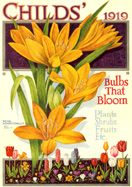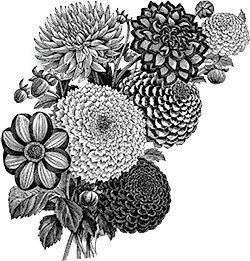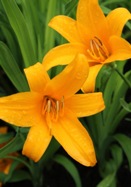Order these spring-planted bulbs NOW for shipping in the next week.
All bulbs for spring 2025 are SOLD OUT.
Order for spring 2026 starting September!
when spring bulbs are back for sale.
|
ARE DAYLILIES BULBS? Not really, but bulb catalogs in the past offered their thick, fleshy roots, and today many antique daylilies are at risk, so we’ve added them to our Ark. Modern daylilies can be amazing, but older ones blend better into most gardens. They’re not huge or gaudy, and their classic, lily-like forms are full of grace.
TIPS FOR SUCCESS: Daylilies are one of the easiest of all perennials. See what you’ll get: freshly dug, bare-root plants with 2-4 fans (growing points). Plant in full sun to light shade, and learn more here.
|
|
|
|
|
With cottage-garden grace and surprising diversity, antique daylilies are waiting to be rediscovered by modern gardeners. Sample their old-fashioned charms with 3 of our favorites, all different, labeled, and great for your area. (Several possibilities are pictured.) For zones 4a-8b(9aWC).
For more of each variety, order additional samplers.
Daylily care.
If you’d like to be notified when it’s back in stock, click to sign up for an email alert.
|
|
|
|
Here’s the beginning of daylilies as we know them today. Introduced in 1893 by schoolteacher George Yeld, ‘Apricot’ was the first hybrid daylily and its success opened the door for the 60,000 others that have followed. Spring-blooming (starting in early May here in zone 6a) and often reblooming in the fall, it has vivid little flowers of orange-yellow peeking above a fountain of leaves — making it well worth growing even if it weren’t so historic. 28-34”, early, deciduous, zones 4a-8b(10aWC), from our own micro-farms.
Last offered in 2025. If you’d like to be notified when it’s back in stock, click to sign up for an email alert.
|
|
|
|
Back in the day, ‘Black Falcon’ was celebrated as the darkest daylily of all, and 70 years later it’s still a stunner. A glowing center of molten gold makes its rippled, mahogany-red petals seem even darker. It’s free-flowering, easy-growing, mid-summer blooming, 32-36”, deciduous, 2-3 fans, for zones 4a-8b(10aWC), from our own micro-farm.
Last offered in 2024. If you’d like to be notified when it’s back in stock, click to sign up for an email alert.
|
|
|
|
With its velvety, wine-dark petals, chartreuse throat, and graceful, lily-like form, ‘Black Friar’ is one of the best of the mid-century “black” daylilies. Tall and vigorous, it was bred by the first woman to win the AHS’s top award for hybridizing, “Sun-Proof” Mary Lester of Georgia. 32-38”, mid-to-late, deciduous, 2 fans, zones 4a-8b(10aWC), from our own micro-farm.
Last offered in 2025. If you’d like to be notified when it’s back in stock, click to sign up for an email alert.
|
|
|
|
‘Caballero’s long, curling petals are gold and an intriguing rusty brown (yes, brown!) that may remind you of saddle-leather and sandstone buttes – which is probably just what Stout had in mind when he named it. Caballeros were the noble “gentlemen-cowboys” of popular movies such as The Bold Caballero of 1936 with its dashing hero, Zorro. 36-40”, early-mid season, evergreen, 2 large fans, zones 4a-9b(10bWC), from our own micro-farm.
Last offered in 2025. If you’d like to be notified when it’s back in stock, click to sign up for an email alert.
|
|
|
|
This dramatically tall, colorful daylily will draw your eye from the farthest reaches of your garden. It gets its height – five feet or more here – from H. altissima, native to the mountains of Nanjing, and with 25-30 buds per stem, its striking red flowers will entertain you from mid-summer into fall. By A.B. Stout, 48-72”, deciduous, 2-3 fans, zones 4a-8b(10bWC), from our own micro-farm.
Last offered in 2025. If you’d like to be notified when it’s back in stock, click to sign up for an email alert.
|
|
|
|
With up to 30 buds per stem, this Nebraska-bred classic will brighten your mid-summer garden with six weeks of star-like, jewel-toned blossoms that are as graceful as wildflowers. Named for a hit movie that later inspired Pirates of the Caribbean, it’s another masterpiece from the great Henry Sass whose family introduced so many enduringly popular iris and peonies. 30-32”, mid-season, deciduous, zones 4a-8b(10aWC), from our own micro-farm.
Last offered in 2025. If you’d like to be notified when it’s back in stock, click to sign up for an email alert.
|
|
|
|
True stock! Many daylilies are mistakenly called lemon lily, but ours is the true original. For centuries, this and the single orange “ditch lily” were the only daylilies common in gardens. Always the more prized, lemon lily is smaller, much more graceful, and early blooming, with a sweet scent that led one botanist in 1733 to call it the “Yellow Tuberose.” Best in cool climates and moist soils. We ship single fans of this great rarity. Formerly H. flava, 24-32”, deciduous, zones 3a-7a(9aWC), from our own micro-farm.
If you’d like to be notified when it’s back in stock, click to sign up for an email alert.
|
|
|
|
One of the oldest daylilies of all, and very hard to find today. This lightly fragrant beauty came from a clump growing in OHG founder Scott’s front yard – until we dug it up to share with you. (No problem!) It was bred by R. Wallace and Co., importers of some of the first daylilies from China, and praised in the June 1900 Country Life as “a Day Lily of great beauty, vigorous and handsome.” 28-32”, early-mid, deciduous, 2 fans, zones 5a-8a(10aWC), from our own micro-farm.
Last offered in 2025. If you’d like to be notified when it’s back in stock, click to sign up for an email alert.
|
|
|
|
When we asked the experts, this pastel gem topped the list of heirloom daylilies we just had to offer. Its pale, melon-pink color was an exciting advance for the 1950s, and – enhanced by a cool green throat – it’s still exciting and lovely today. Winner of the Stout Medal, it was bred by Edna Spalding of rural Louisiana who grew her seedlings in the vegetable garden and culled the rejects with a kitchen knife. 32”, mid-summer blooming, deciduous, zones 4a-8b(10bWC), from our own micro-farms.
Last offered in 2025. If you’d like to be notified when it’s back in stock, click to sign up for an email alert.
|
|
|
|
With a name that’s pure 1950s, this luscious daylily looks like a cool, refreshing cantaloupe and ice cream smoothie. It was bred by Orville Fay of Illinois whose day job was working as a chemist in a candy factory. Just 30” tall, mid-summer blooming, deciduous, 3-4 fans, zones 5a-8b(10aWC), from Missouri & our own micro-farm.
Last offered in 2024. If you’d like to be notified when it’s back in stock, click to sign up for an email alert.
|
|
|
|
Much more than just another yellow daylily, ‘Ophir’ has unusually long, trumpet-shaped flowers – almost like an Easter lily – making it one of the most graceful and distinctive daylilies we’ve ever seen. It’s also one of the first American-bred daylilies, by Bertrand Farr, and the great Elizabeth Lawrence grew it, writing in 1943 that it was “more beautiful than ever this season, and the only attention it has ever had is a mulch of cow manure each fall.” 38-46”, mid-season, semi-evergreen, 2-3 fans, zones 4a-8b(10aWC), from our own micro-farm.
Last offered in 2025. If you’d like to be notified when it’s back in stock, click to sign up for an email alert.
|
|
|
|
We love how profusely this charming little daylily blooms, and how its small, rusty red flowers glow warmly in the summer sun. Bred by the great A.B. Stout, it was named by globe-trotting “lady botanist” Mary Gibson Henry in memory of her youngest son, Porteous. 26-32”, early-mid to mid, semi-evergreen, zones 4a-8a(10aWC), from our own micro-farm.
Last offered in 2024. If you’d like to be notified when it’s back in stock, click to sign up for an email alert.
|
|
|
|
With its red-violet undertones, this Stout Medal winner was an exciting color advance for its time, and although no one today would describe it as “pansy purple,” it’s still a striking flower. And potent – it often develops small plantlets called proliferations on its bloom stalks which you can root and grow into new plants! 36-42”, mid to late-mid, deciduous, 2-3 fans, zones 4a-8a(10aWC), from our own micro-farm.
Last offered in 2024. If you’d like to be notified when it’s back in stock, click to sign up for an email alert.
|
|
|
|
60 years ago this tall, dark-red/burgundy daylily caused ripples with its long elegant petals and vigorous growth. It contrasts beautifully with yellow and gold neighbors and can rebloom throughout the summer. 36”, early-mid, 2-3 fans, zones 4a-8b(10bWC), from our own micro-farm.
Last offered in 2025. If you’d like to be notified when it’s back in stock, click to sign up for an email alert.
|
|
|
|
One of the most famous daylilies of all, this wild beauty was the best of the three reddish forms of Hemerocallis fulva sent to A.B. Stout from China in 1924 – and which Stout used to breed the very first of the thousands of pink, red, and purple daylilies that have graced gardens ever since then. Rusty red with a darker eye-zone, 38-42”, late-mid, dormant, 2 large fans, zones 4a-8a(10aWC), from our own micro-farm.
Last offered in 2024. If you’d like to be notified when it’s back in stock, click to sign up for an email alert.
|
|
|
|
Bred by Ophelia “Bright” Taylor, winner of the AHS’s highest award for hybridizers, this purple-shaded, wine-colored daylily has slender petals curling back gracefully from a vivid yellow throat. It’s been a favorite oldie of our Missouri growers for over 40 years thanks to its “rich color, recurved petals, and beautiful foliage.” 32-36”, mid-season, semi-evergreen, 2-3 fans, zones 5a-9a(10aWC), from our own micro-farm.
Last offered in 2024. If you’d like to be notified when it’s back in stock, click to sign up for an email alert.
|
|
|
|
This rarely offered, landmark daylily was bred by A.B. Stout, the New York Botanic Garden scientist who unlocked the amazing potential of daylilies, setting them on the road to superstardom. Although Stout introduced 92 remarkable daylilies, he’s said to have been especially proud of ‘Theron’, whose mahogany blooms made it the first “red” daylily. 30”, early-mid blooming, deciduous, 2-3 fans, zones 4a-8b(9bWC), from our own micro-farm.
Last offered in 2024 If you’d like to be notified when it’s back in stock, click to sign up for an email alert.
|
|
DAYLILY ARCHIVES — For customer tips and raves, history, news, and more, see our Daylillies Newsletter Archives.
PLANTING & CARE — Plant these bare-root perennials as soon as possible in the spring. They’re eager to grow, can take light frost, and need water and sunlight to stay healthy. If necessary, store in a plastic bag in the refrigerator for a few days or “heel in” briefly in moist sand or soil in a shady spot.
Daylilies like lots of sun but most bloom well in light shade, too, and often prefer it in the South. Loamy, well-drained soil suits them best, but they’re adaptable and should do fine in any soil that’s not too wet or dry.
Plant 18-24 inches apart (to leave growing room for future years) with the crown (where the foliage meets the roots) no more than one inch below the soil surface. Dig a hole big enough to fit the roots comfortably, mound soil in the center, set the plant on top, and spread the roots out down the sides of the mound. Fill in and firm soil around roots, making sure the crown ends up no more than one inch deep. Water well.
Water regularly, especially the first year and from spring till flowering in future years. First-year plants usually bloom sparsely — if at all — concentrating instead on developing a strong root system. Deadhead (remove) spent blooms daily for a neater look and, to increase bloom the following year, remove any seedpods that may form.
After bloom, normal senescence (aging) may cause foliage to subside, yellow, or turn brown at the tips. If this bothers you, feel free to trim it a bit or even cut the foliage to the ground completely — though not the first year! With good care, fresh new foliage will emerge.
Daylilies are hardy perennials and winter protection is rarely needed. In spring, remove dead foliage, fertilize if indicated by a soil test, and resume watering.
For more information, including tips on the few pests and diseases that occasionally trouble daylilies, see the “Frequently Asked Questions” section of the excellent American Hemerocallis Society website.
|































